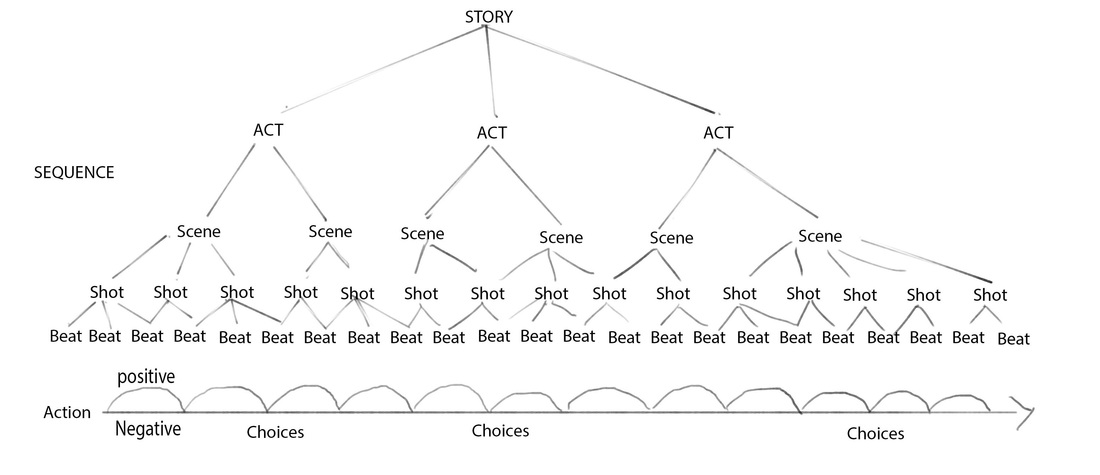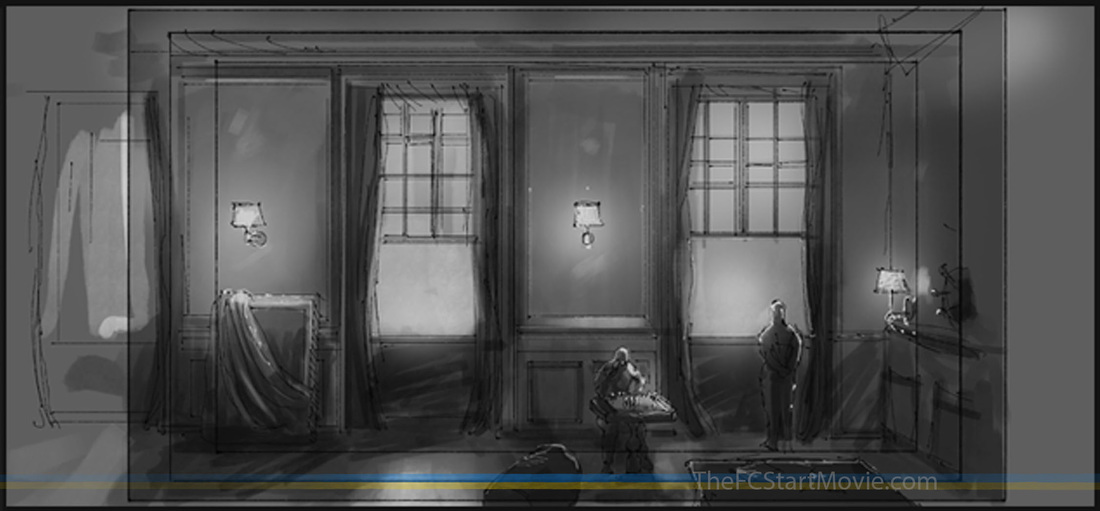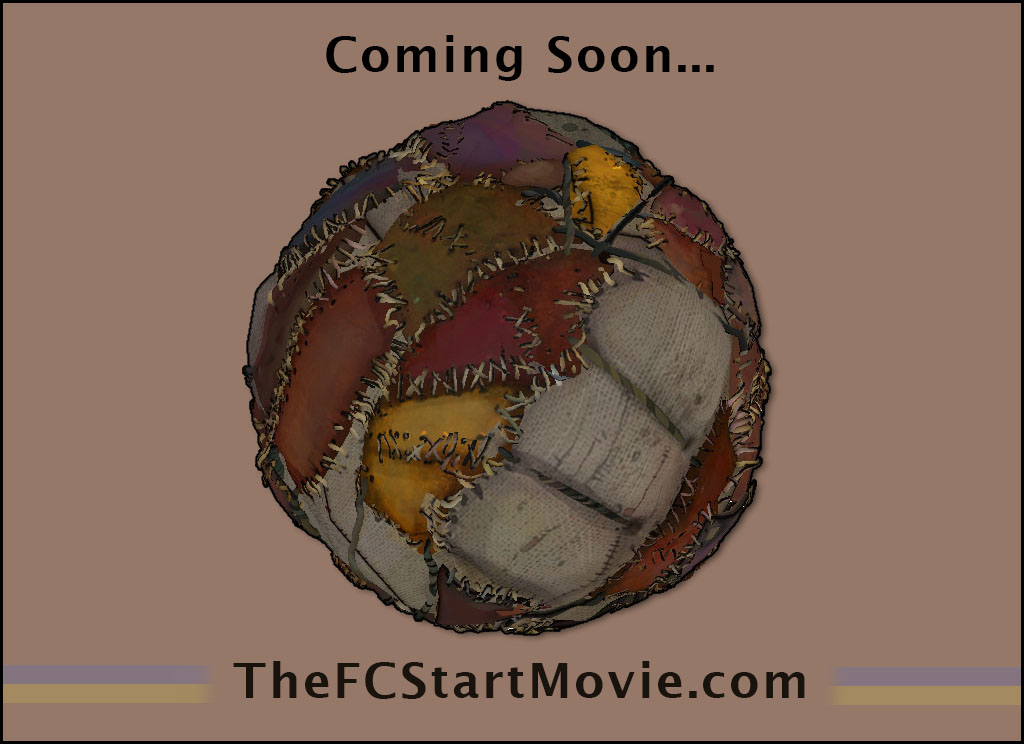How Do Stories Work?
Once a month, through email, I share a video behind the scenes of our film. I show some of the work, but also share experiences, stories, and antecdotes along the way.
If you missed the last video, here is a fun and informative look at a question raised by a fan.
"How do the scenes of the story come together?"
Origins of Story
A story is broken into sections, like an architecture is framed, divided, and then fleshed out. But a story starts from one particular nucleus: The protagonist.
Every story must have a protagonist which meets forces of antagonism. Without these two counterpoints, you do not have a story. You may have a portrait, but without conflict, there is no story.
When we refer to "character," we are not referring to traits, but to the resulting effect of the protagonist's (or antagonist's) actions. For example, a supposed "bad guy" could wear Batman's costume throughout a film and perform villainous acts. He may look like Batman, but his choices tell us he is not Batman.
Therefore, the costume is the characteristic, the choices are the character.
For this reason, we should use the word "protagonist" in place of character.
Every story must have a protagonist which meets forces of antagonism. Without these two counterpoints, you do not have a story. You may have a portrait, but without conflict, there is no story.
When we refer to "character," we are not referring to traits, but to the resulting effect of the protagonist's (or antagonist's) actions. For example, a supposed "bad guy" could wear Batman's costume throughout a film and perform villainous acts. He may look like Batman, but his choices tell us he is not Batman.
Therefore, the costume is the characteristic, the choices are the character.
For this reason, we should use the word "protagonist" in place of character.
The story begins when the protagonist's life is thrown out of balance. Something happens that creates a crisis, which must be resolved. He or she now has a desire, and that desire drives the action. This is why an assistant director yells "Action." Stories told on screen are not told by telling an actor to go ahead and "Think." We know the character through action only.
An incident forces the protagonist to start making choices. Each choice is met with more antagonism, creating rising action through turning points. These choices do not resolve the conflict, but they bring us closer, as each choice rasies the price of a final decision.
This final choice must be an unavoidable truth, which we call 'character.' In a successful story, we don't know the character until that final, unavoidable choice. And this final choice must resolve whatever threw their life out of balance at the beginning of the story.
Character is a residue of action, it's the truth we discover only after the story has been told.
Often, up to that point, the character is either lying to himself/herself, "wears a mask," or he or she has yet to fully realize what the story has been telling us all along. Once the protagonist makes that final choice, the story has resolved itself.
Story Design
Composing this story idea for film can be understood in structural terms as well. Imagine that music is composed of little notes that come together in sequence. Notes create movement, but the musician is not composing notes, the musician is composing song, and using notes to do it.
The musician is creating patterns of harmony that result in an inner world, which frames up an experience for the audience. It's very similar for film.
The musician is creating patterns of harmony that result in an inner world, which frames up an experience for the audience. It's very similar for film.
Let's consider story the same way we consider character to be a sum of it's parts. We don't have character without the sum of choices which reveal a truth in the face of antagonism. It's no coincidence that the word drama is so similar to the word trauma. Conflict creates story.
And a story is told and complete, and successful, only when we arrive at final character, or final truth.
Acts are a way of organizing story. Their existence should be almost invisible to the audience.
The Act is composed of scenes, which flow together in sequence.
I define a scene by it's transition. Somewhere, within the rising action, a transition occurs between two polar opposites. For example, a situation may be good for the protagonist in one moment. When it shifts to it's polar opposite, a scene has just occured. The best scenes end immediately after this transition, which carries us into the next scene.
The scene is composed of beats of action. The storyteller uses beats the same way musicians use notes - to carry the movement. Not to show how great an actor is at his characteristics. Each beat must be building into a scene.
And a story is told and complete, and successful, only when we arrive at final character, or final truth.
Acts are a way of organizing story. Their existence should be almost invisible to the audience.
The Act is composed of scenes, which flow together in sequence.
I define a scene by it's transition. Somewhere, within the rising action, a transition occurs between two polar opposites. For example, a situation may be good for the protagonist in one moment. When it shifts to it's polar opposite, a scene has just occured. The best scenes end immediately after this transition, which carries us into the next scene.
The scene is composed of beats of action. The storyteller uses beats the same way musicians use notes - to carry the movement. Not to show how great an actor is at his characteristics. Each beat must be building into a scene.
Composing Story as Motion Pictures
Each beat of action in a motion picture is captured in the image. An actor may move about, creating these beats of actions, and the filmmaker must decide how to compose those notes in a sequence that best communicates his or her intentions to the audience. Several beats usually happen in a shot, but sometimes one or two beats of action happen and then the shot cuts to the next.
Fundamentally, we may understand camera direction with a few simple concepts that may be combined endlessly, with a variety of results in the composition of story:
Fundamentally, we may understand camera direction with a few simple concepts that may be combined endlessly, with a variety of results in the composition of story:
The master shot, or establishing shot tells us where we are, as well as gives the audience a chance to be an observer. The wide shot may alienate the audience, or it may give them a chance to refresh after a previous moment.
The coverage and medium shots allow the audience to feel they are a part of whatever is happening on screen. The heart of the story often occurs in these shots because of their intimacy. The audience is the third participant in the action that's occuring above.
The close up shots point to something specific in the scene. In designing camera with mediums and wides, these closeups work best when the filmmaker wants the audience to remember something, or recognize it's importance, and for this reason, they should be used selectively in a design relying on these shot patterns.
Although this can be a simple way of looking at shot design, these are the fundamentals from which a film story may be told successfully on screen. A musician has only a range of what we call 12 notes, but through those twelve notes, Mozart composed his greatest symphonies, and with those same 12 notes, Justin Bieber composed his worst.
Although this can be a simple way of looking at shot design, these are the fundamentals from which a film story may be told successfully on screen. A musician has only a range of what we call 12 notes, but through those twelve notes, Mozart composed his greatest symphonies, and with those same 12 notes, Justin Bieber composed his worst.
Know More
If you like to receive more, I recommend joining us by signing up for our behind the scenes updates. Once a month, I send out a short video sharing what we are up to, and I address the challenges of making a film. It's entertaining and hopefully informative. Plus, you can see some of the work going into our movie.








 RSS Feed
RSS Feed

